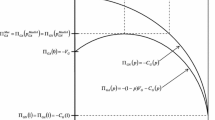Abstract
We present models of differential terror queue games, wherein terrorists seek to determine optimal attack rates over time, while simultaneously the government develops optimal counterterror staffing levels. The number of successful and interdicted terror attacks is determined via an underlying dynamic terror queue model. Different information structures and commitment abilities derive from different assumptions regarding what the players in the game can and cannot deduce about the underlying model. We compare and explain the impact of different information structures, i.e., open loop, closed loop, and asymmetric. We characterize the optimal controls for both the terrorists and the government in terms of the associated state and costate variables and deduce the costate equations that must be solved numerically to yield solutions to the game for the different cases. Using recently assembled data describing both terror attack and staffing levels, we compare the differential game models to each other as well as to the optimal control model of Seidl et al. (Eur J Oper Res 248:246–256, 2016). The paper concludes with a discussion of the lessons learned from the entire modeling exercise.




Similar content being viewed by others
Notes
In the subsequent time, argument t is omitted for notational convenience unless necessary.
Thus, players do not deduce how their opponent actually determines its decision rule despite having full information about the game. This is probably the main reason why in the literature closed-loop or feedback solutions are seen as more reasonable than open-loop strategies.
In general, nonzero-sum differential games which admit a unique open-loop Nash equilibrium solution have uncountably many Nash equilibrium solutions if the information structure is extended (see, e.g., [2]). This informationally nonuniqueness is based on the dynamic nature of the information. However, using the above method implies a canonical system of ordinary differential equations which has a unique steady state.
Note, however, that this is also strongly related to the used parameters. If the costs of terror plots are lower or the utility is higher, results are the opposite.
The reason for the sign of \(\eta _y\) is that for the terrorists a high Y is beneficial since then interdiction prevents agents from detecting new plots.
References
Appelbaum B (2011) As US agencies put more value on a life Businesses fret. New York Times, Feb 16
Basar T (1977) Informationally nonunique equilibrium solutions in differential games. SIAM J Control Opt 15:636–660
Basar T, Olsder GJ (1982) Dynamic noncooperative game theory. Academic Press, London
Cellini R, Lambertini L (2005) R&D incentives and market structure: dynamic analysis. J Optim Theory Appl 126:85–96
Dockner E, Jorgensen S, Long NV, Soger G (2000) Differential games in economics and management science. Cambridge University Press, Cambridge
Enders W, Sandler T (2012) The political economy of terrorism. Cambridge University Press, New York
Feinstein JS, Kaplan EH (2010) Analysis of a strategic terror organization. J Confl Resolut 54:281–302
Grass D, Caulkins JP, Feichtinger G, Tragler G, Behrens D (2008) Optimal control of nonlinear processes: with applications in drugs, corruption and terror. Springer, Berlin
Jacobson D, Kaplan EH (2007) Suicide bombings and targeted killings in (counter-) terror games. J Confl Resol 51:772–792
Kaplan EH, Kress M, Szechtman R (2010) Confronting entrenched insurgents. Oper Res 58:329–341
Kaplan EH (2010) Terror queues. Oper Res 58:773–784
Kaplan EH (2012) Estimating the duration of Jihadi terror plots in the United States. Stud Confl Terr 35:880–894
Kaplan EH (2013) Staffing models for covert counterterrorism agencies. Soc Econ Plan Sci 47:2–8
Kaplan EH (2015) Socially efficient detection of terror plots. Oxf Econ Pap 67:104–115
Long NV (2010) A survey of dynamic games in economics. Surveys of theories in economics and business administration, 1st edn. World Scientific, Singapore
Seidl A, Kaplan EH, Caulkins JP, Wrzaczek S, Feichtinger G (2016) Optimal control of a terror queue. Eur J Oper Res 248:246–256
Strom K, Pope M, Hollywood J, Weintraub G, Daye C, Gemeinhardt D (2010) Building on clues: examining successes and failures in detecting US terrorist plots 1999–2009. Institute for Homeland Security Solutions, Research Triangle Park, North Carolina
Viscusi WK, Aldy JE (2003) The value of a statistical life: a critical review of market estimates throughout the world. J Risk Uncertain 27:5–76
Acknowledgments
This research was supported by the Austrian Science Fund (FWF) under Grants P25979-N25 and P25275-G11.
Author information
Authors and Affiliations
Corresponding author
Rights and permissions
About this article
Cite this article
Wrzaczek, S., Kaplan, E.H., Caulkins, J.P. et al. Differential Terror Queue Games. Dyn Games Appl 7, 578–593 (2017). https://doi.org/10.1007/s13235-016-0195-1
Published:
Issue Date:
DOI: https://doi.org/10.1007/s13235-016-0195-1




